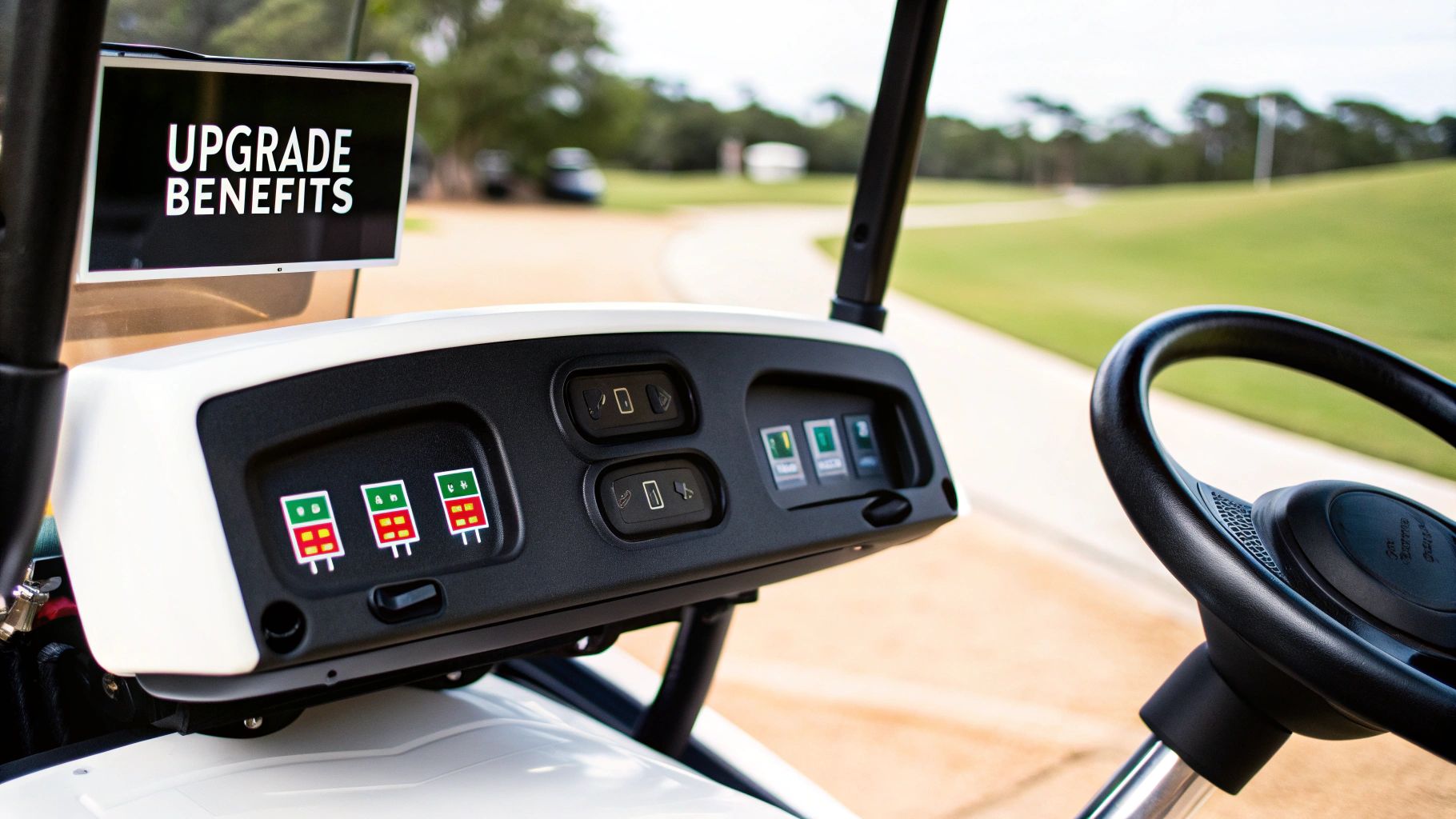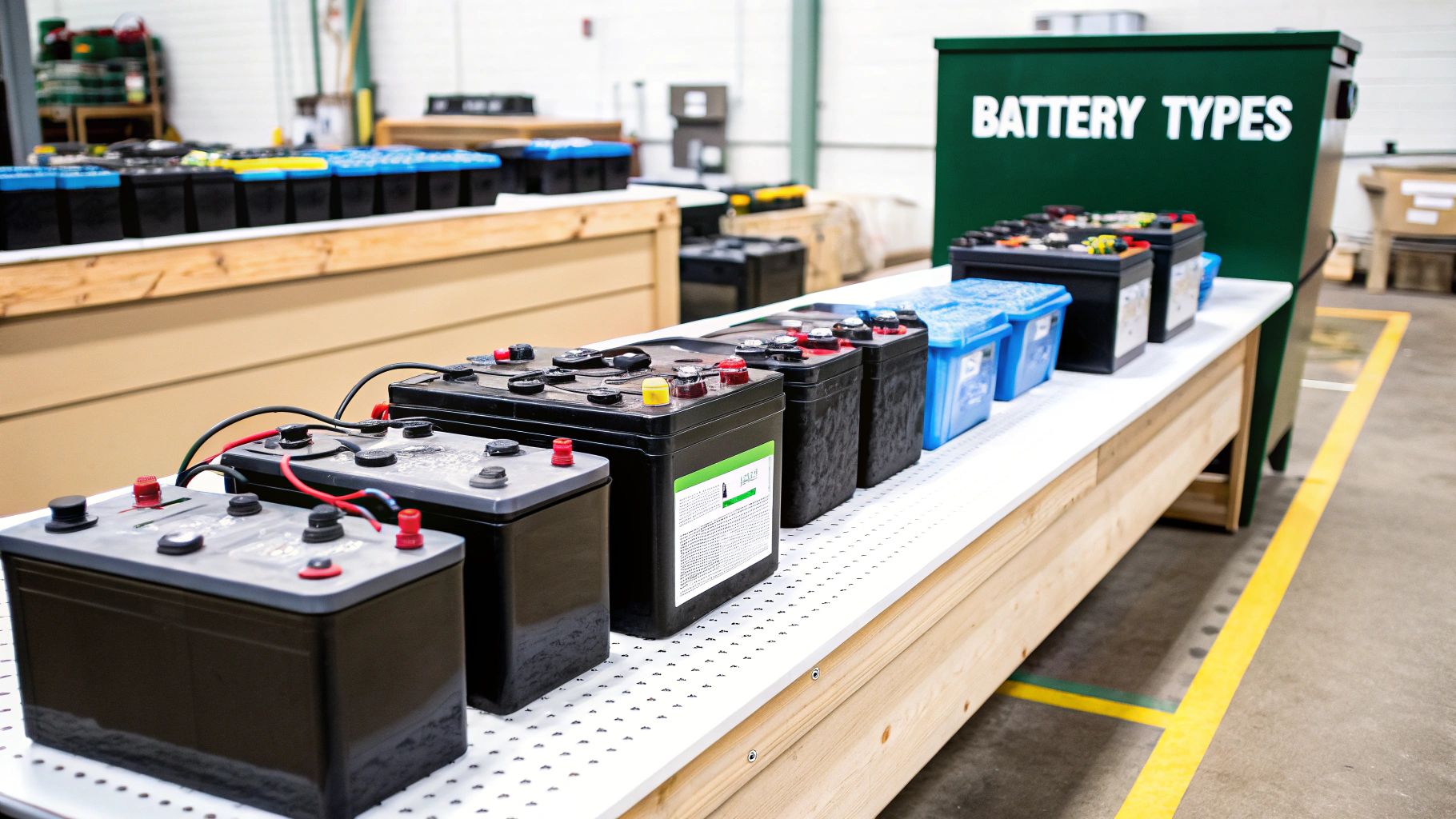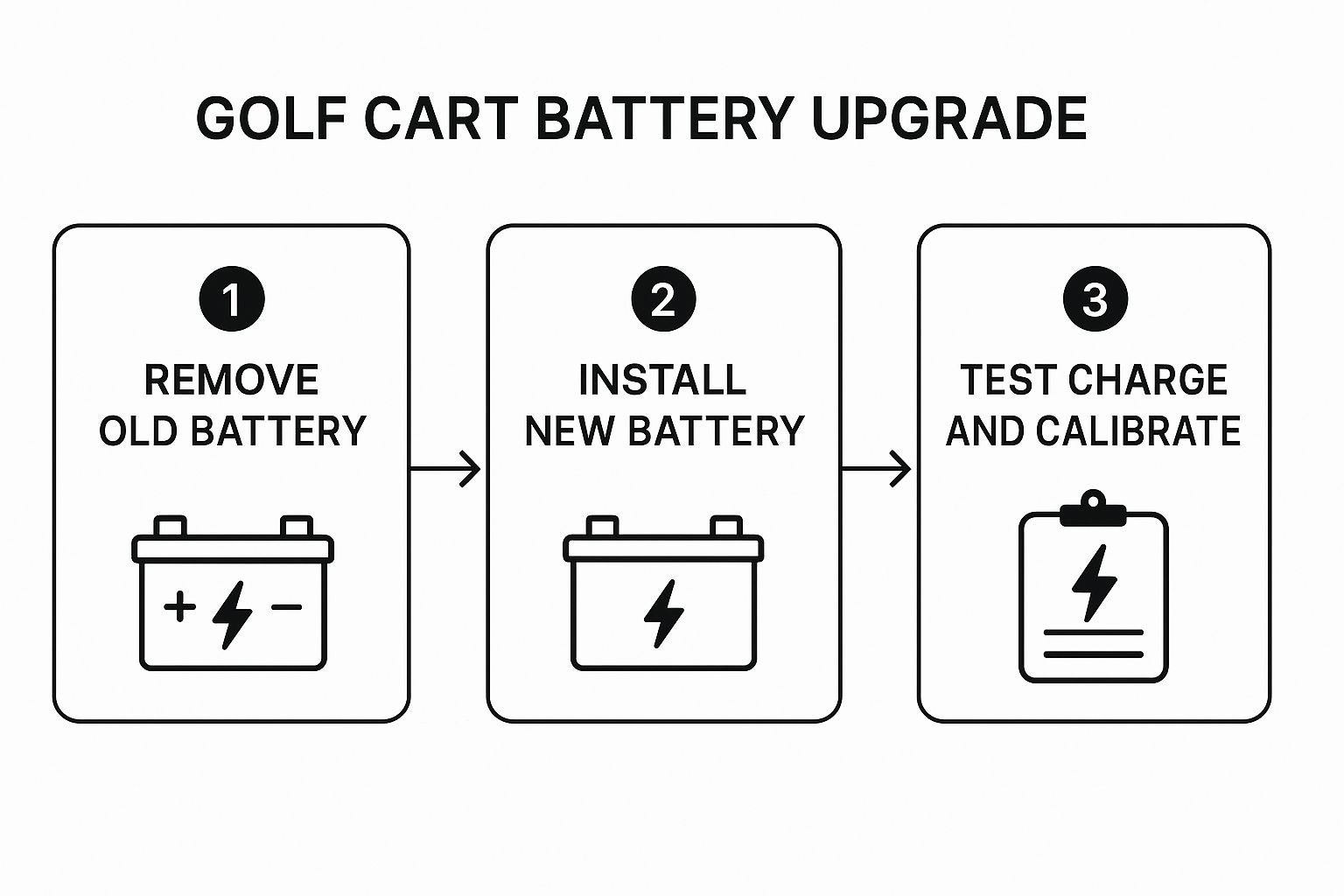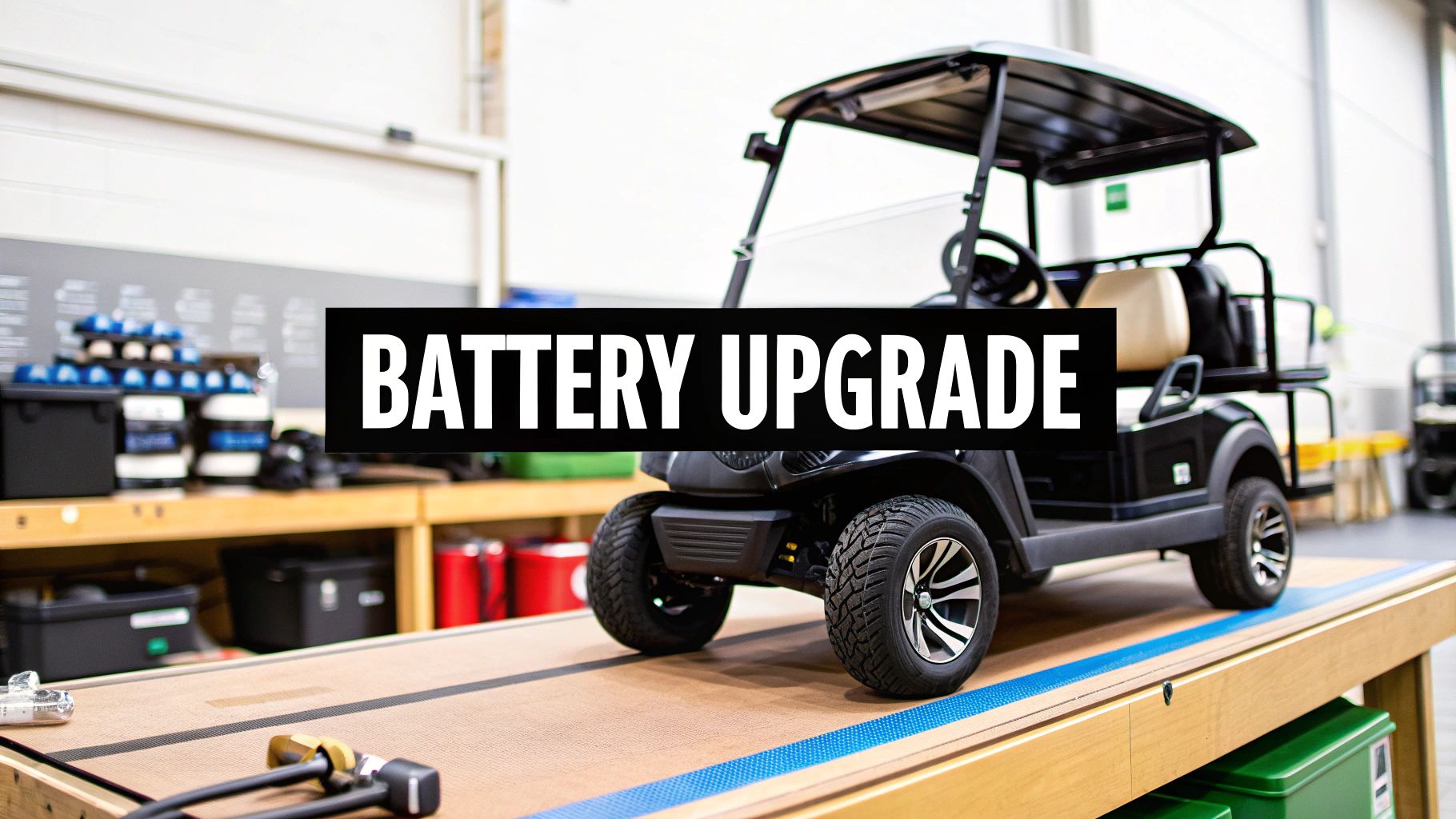Thinking about a golf cart battery upgrade is a great move. It’s one of the best ways to seriously boost performance, stretch your range, and cut down on annoying maintenance. The moment you swap out those old, heavy lead-acid batteries for a modern lithium-ion system, you'll feel the difference. We're talking noticeably faster acceleration and a huge reduction in your cart's weight, making it feel zippier and more responsive on any surface.
Is a Golf Cart Battery Upgrade Really Worth It?

Deciding to upgrade your golf cart's battery isn't just about replacing a part; it's about completely transforming how you use your cart. Yes, the upfront cost of lithium can feel a bit steep, but you have to look at the bigger picture. It’s an investment that pays you back in performance, saved time, and sheer convenience.
Just think about your routine now. Are you tired of the constant upkeep that lead-acid batteries demand? I’m talking about checking water levels, scrubbing away at corroded terminals, and all the other little chores. A lithium upgrade gets rid of all that. Completely. Your weekends are yours again.
Real-World Performance Gains
The benefits of a battery upgrade aren't just numbers on a spec sheet—they’re things you’ll actually feel every time you get behind the wheel. A lighter cart isn't just a fun fact; it means less wear and tear on the turf and a much more responsive feel the second you step on the pedal.
Here’s a breakdown of the practical perks you can expect:
- Go Further, Worry Less: You can pretty much double your range with a quality lithium battery. That means getting through 36 holes is no problem, and you can spend an entire day cruising the neighborhood without a hint of range anxiety.
- Power That Doesn't Fade: Lead-acid batteries are notorious for getting sluggish as they drain. Lithium, on the other hand, delivers consistent, strong power right until it's nearly empty. Your cart will tackle hills just as powerfully at the end of the day as it did at the start.
- Get Back on the Road Faster: This is a huge one. Lithium batteries can recharge in as little as 2-4 hours. Compare that to the 8-10 hours you're used to with lead-acid. For families who use their cart all the time or for fleet managers, this is a massive advantage.
The decision to upgrade is really an investment in your own efficiency. You’re not just buying a new battery; you’re buying back your time and ditching the constant hassle of old-school battery maintenance.
This shift toward better battery tech is happening everywhere. The global golf cart battery market, currently valued around $1.2 billion, is on track to more than double to $2.5 billion by 2034. That explosive growth is all thanks to the undeniable advantages in performance and energy efficiency that modern batteries offer. If you're curious about the numbers, you can dig into this detailed report on the global golf cart battery market.
Quick Look: Lead-Acid vs. Lithium Battery Upgrade
To really see the difference, it helps to put the two side-by-side. This table breaks down what you can expect when you move from traditional lead-acid batteries to a modern lithium setup.
| Feature | Traditional Lead-Acid | Modern Lithium-Ion Upgrade |
|---|---|---|
| Weight | Very heavy (300+ lbs) | Lightweight (under 100 lbs) |
| Maintenance | Regular watering & cleaning | Zero maintenance required |
| Lifespan | 3-5 years | 10+ years |
| Charge Time | 8-10 hours | 2-4 hours |
| Performance | Power fades as it drains | Consistent power until empty |
| Upfront Cost | Lower | Higher |
As you can see, while the initial cost for lead-acid is lower, lithium wins in nearly every other category that matters for day-to-day use and long-term value.
Choosing Your New Power Source: Lithium vs. Lead-Acid

This is the biggest decision you'll make when replacing your golf cart's batteries. It’s more than just a technical choice; picking between traditional lead-acid and modern lithium-ion batteries will define your cart's performance, how much time you spend on maintenance, and your overall satisfaction for years to come.
Let's move beyond the spec sheets and talk about how these two power sources actually stack up in the real world.
For decades, lead-acid batteries have been the go-to, mostly because they’re cheaper upfront. They're the familiar, budget-friendly option that gets the job done. But that initial savings comes at a cost—your time and effort. You’re essentially signing up for a routine of checking water levels, carefully topping them off, and scrubbing away the inevitable corrosive buildup on the terminals.
Their weight is another huge factor. A full set of lead-acid batteries can easily add over 300 pounds to your cart. That extra bulk affects everything from how your tires treat the turf to how the suspension handles bumps. It also means your motor has to work a lot harder, especially when you’re trying to climb a hill.
The Lithium Advantage in Action
Then you have lithium-ion batteries. Upgrading to a lithium golf cart battery is like fast-forwarding to a more convenient, "set it and forget it" lifestyle. There is zero regular maintenance. No more watering, no acid spills, and no corrosion to clean. You just charge it up and head out.
That convenience also shows up in charging times. A lithium battery can get a full charge in just 2-4 hours. That's a world away from the 8-10 hour cycle needed for lead-acid. For a busy family using their cart daily or a golf course needing quick cart turnarounds, this is a total game-changer. The performance boost you get from a lithium upgrade is something you can really feel.
The weight savings alone are dramatic—you’re often shedding over 200 pounds from your cart. This isn't just a number on a page; it translates directly into snappier acceleration and makes climbing hills feel effortless. Your cart feels more nimble and powerful because it’s not dragging all that extra lead around.
The market is definitely taking notice. The golf cart lithium-ion battery segment is booming, currently estimated at around $500 million. Experts predict it will grow by about 15% annually, driven by the clear performance edge of lithium technology. You can dig into the data behind this trend by reviewing the findings on the golf cart lithium battery market.
Head-to-Head Real-World Comparison
To lay it all out, let's put these two side-by-side based on the practical things that will affect your daily use.
| Consideration | Traditional Lead-Acid | Modern Lithium-Ion |
|---|---|---|
| Daily Effort | Requires regular watering and terminal cleaning. | Absolutely no maintenance needed. |
| Cart Handling | Heavy; can feel sluggish, especially on hills. | Lightweight; improves acceleration and hill climbing. |
| Downtime | 8-10 hours to fully recharge. | 2-4 hours to fully recharge. |
| Longevity | Typically lasts 3-5 years with proper care. | Often lasts 10+ years, providing superior value. |
Ultimately, while lead-acid has a lower price tag at the checkout, lithium delivers far greater long-term value, convenience, and a much better driving experience. For most owners who plan on keeping their cart for more than a few years, the benefits of a lithium golf cart battery upgrade make it the clear winner.
Matching Battery Specs to Your Cart and Lifestyle

Picking the right battery isn't as simple as grabbing the first one you see off the shelf. It’s really about getting the technical specs lined up with your specific cart and, just as importantly, how you actually use it. I know that diving into things like voltage and amp-hours can feel a bit like reading a foreign language, but trust me, getting a handle on these is the secret to a successful battery upgrade.
First things first, let's talk voltage (V). Your cart’s entire electrical system is built to run on a specific voltage, which is almost always either 36V or 48V. This is the one spec you can't get wrong. You absolutely have to match it. A 36V cart needs a 36V battery pack, and a 48V cart needs a 48V pack. No exceptions. If you try to mix and match, you’re just asking for trouble—you'll risk frying your motor, controller, and the new battery itself.
How Much Range Do You Really Need?
Next up is amp-hours (Ah). This is where you match the battery to your lifestyle. The easiest way to think about amp-hours is like the gas tank in your car. A higher Ah rating means a bigger tank, which gives you more range before you have to plug in and recharge.
So, how many amp-hours do you need? It all comes down to how you use your cart.
- The Casual Neighborhood Cruiser: If your cart time is mostly short, flat trips around the community or to the local pool, a lower-range Ah battery will do the job just fine. Something in the 60-80Ah range is usually plenty.
- The Avid Golfer: For those of us who live on the course and regularly play 18 to 36 holes, especially on hilly tracks, you’ll want more juice. Look for a battery in the 100-120Ah range. This gives you the confidence that you'll finish your second round with power to spare.
- The Heavy-Duty User: Is your cart lifted? Sporting big, beefy tires? Often loaded with friends, family, or gear? If you're using it for more than just a joyride, you need a high-capacity battery. A pack with 150Ah or more will deliver the endurance needed to handle that extra strain without constantly needing a charge.
Choosing the right amp-hour capacity is a balancing act. While more range is always nice to have, it also comes with a bigger price tag. Understanding how these factors influence the cost will help you make a smart investment. We break this down even further in our golf cart battery replacement cost guide.
Ensuring a Perfect Physical Fit
Last but not least, don't forget about the physical size. It's a simple thing, but it's often overlooked. While most modern lithium batteries are sold as "drop-in" replacements, you should always break out the tape measure. Check the dimensions of your battery tray and compare them to the spec sheet of the battery you’re considering.
This one small step can save you the massive headache of trying to return a battery that simply won't fit. Just measure these three things:
- Length (L)
- Width (W)
- Height (H)
Manufacturers always list these dimensions clearly. Taking five minutes to measure your tray will ensure your installation is quick, smooth, and secure. A battery that fits snugly is not only safer but will perform more reliably for years to come.
A Practical Guide to Installing Your New Batteries
Alright, you've picked out your new batteries. Now for the hands-on part. Swapping out your golf cart's power source is a pretty straightforward job, but I can't stress this enough: safety has to be your top priority. With the right gear and a methodical approach, you can have your cart powered up and ready to roll in just an afternoon.
Before you even think about touching a wrench, let's talk safety. Batteries, especially the old lead-acid ones, pack a serious punch and need to be handled with respect. First thing's first, get your protective gear ready.
- Safety Glasses: This is non-negotiable. You need to protect your eyes from potential sparks or any acid splash if you're pulling out old lead-acid batteries.
- Gloves: A good pair of insulated, acid-resistant gloves will be your best friend during this process.
- Insulated Tools: Use wrenches with rubber grips. If you don't have any, a quick pro-tip is to wrap the handles of your metal wrenches with a few layers of electrical tape. This simple step can prevent a nasty shock if a tool accidentally bridges two terminals.
Once you’re geared up, find a good spot to work. A flat, well-ventilated garage or driveway is ideal. Make sure the cart is on level ground, turn the key to the OFF position, and—this is critical—take the key out. Finally, flip the cart's tow/run switch into the TOW/MAINTENANCE position. This is your main safety net, as it deactivates the entire electrical system, preventing any unexpected movement or electrical mishaps.
Safely Removing the Old Batteries
Before you disconnect a single wire, pull out your phone and take a clear, well-lit picture of the current battery wiring. Seriously, do not skip this step. This photo will be your roadmap later on, and trust me, it has saved countless people (myself included) from a world of frustration.
Now you can start the disconnection process. Always begin with the main negative (-) terminal. This is the cable that links the entire battery pack to the cart itself. Once that's off, you can work your way through the rest of the cables, disconnecting and moving them aside one by one.
With all the cables free, it's time to lift the old batteries out. Brace yourself, especially if they're lead-acid—those things can weigh upwards of 60 pounds each. This is a great time to call in a favor from a friend to help with the heavy lifting.
Installing Your New Power Source
With the old batteries out, take a minute to inspect and clean the battery tray. Get rid of any dirt, leaves, or corrosion that's built up over the years. A clean tray not only helps your new batteries sit securely but also prevents corrosion problems down the line.
This whole process really just boils down to a few key stages.

As you can see, it's a logical flow from removal to installation and then to the final checks. Nothing too complicated.
Now, carefully place your new batteries into the clean tray. Use your manufacturer’s diagram or that "before" photo you took to get the layout right. Once they’re in position, secure them with the hold-down brackets. You want them to be snug and completely unable to shift around.
Grab your wiring picture and start connecting the cables, but this time in the reverse order of how you removed them. Start with the smaller jumper cables that link the batteries together. The last cables you'll connect are the main positive (+) and main negative (-) terminals. Double-check that every connection is tight.
Pro Tip: Once all the terminals are tightened down, grab some anti-corrosion spray or gel and apply a thin coat to each one. This creates a protective barrier that will fight off corrosion and keep your electrical connections solid for years. It's a small step that makes a huge difference.
If you're upgrading to a lithium battery system, you’ll have a couple of extra components to install, like the new charger receptacle and the state-of-charge meter. The good news is that most kits are designed with simple plug-and-play connections, which makes this part a breeze.
With everything connected and secure, flip the tow/run switch back to RUN, and you're all set for the final checks.
Post-Upgrade Care for Maximum Battery Life
You've successfully upgraded your golf cart's batteries and are probably already feeling the difference on the course. That’s great, but the job isn't quite finished. To really protect your investment and squeeze every bit of performance out of it for years, you’ll need a smart care routine.
The right approach depends entirely on whether you went with traditional lead-acid or modern lithium batteries. Their long-term needs are worlds apart.
The Old-School Routine for Lead-Acid
If you installed a fresh set of lead-acid batteries, your maintenance tasks will feel familiar, but they’re more critical than ever with a new set. Sticking to a consistent care schedule is the only way you'll see the full 4-6 year lifespan you’re expecting.
This starts with establishing a routine for regular watering. You have to keep an eye on the electrolyte levels to make sure they always cover the internal plates. Letting them run dry is a surefire way to kill a battery.
On top of that, keeping the battery terminals clean is a must. A simple wire brush paired with a baking soda and water paste will prevent the nasty corrosion that chokes off power and leaves you stranded. Don't forget about periodic equalization charges, either—it's a crucial step for balancing the voltage across all cells and fighting off sulfation.
The Lithium Difference in Long-Term Care
For those of you who made the jump to lithium, your maintenance to-do list is refreshingly short. This is that "set it and forget it" advantage you paid for, and it’s a game-changer.
Lithium-ion batteries need zero watering, no equalization, and no messy acid-related cleaning. Their built-in Battery Management System (BMS) is the brains of the operation, automatically handling cell balancing and protecting against issues like overcharging.
Even though they're nearly maintenance-free, a couple of quick checks will ensure maximum longevity. A quick visual inspection of the terminals every few months is a good habit, just to be sure all the connections are still tight and secure. Beyond that, your focus shifts entirely from physical upkeep to smart charging habits.
Best Practices for Off-Season Storage
Properly storing your cart during the off-season is vital for both battery types, but it's especially important for protecting your brand-new investment. Extreme temperatures are the enemy of all batteries, so you should always store your cart in a sheltered, temperate spot—never leave it outside to face freezing cold or blistering heat.
The ideal state of charge for storage differs quite a bit between the two chemistries:
- Lead-Acid Batteries: These should be fully charged and then connected to a quality battery tender or maintainer. This trickle charge prevents them from self-discharging and sulfating, which can cause permanent damage in just a few months.
- Lithium Batteries: These should be stored at a partial state of charge, somewhere between 50% and 70%. Leaving a lithium battery at a full 100% charge for extended periods can actually speed up capacity loss over time.
A common mistake is treating new lithium batteries like old lead-acid ones during storage. Leaving a lithium battery on a trickle charger for months is completely unnecessary and can even be counterproductive. Just charge it to the recommended level, disconnect it, and you're good to go.
Following these specific care instructions will ensure your new golf cart batteries deliver peak performance for their entire lifespan. For a more exhaustive breakdown of these routines, check out our complete guide to golf cart battery maintenance, which covers these topics in much greater detail.
Common Questions About Golf Cart Battery Upgrades
Even after you've zeroed in on the perfect golf cart battery upgrade, it's totally normal to have a few questions rattling around. The nitty-gritty details can seem a bit technical, but getting straight answers is the best way to move forward with confidence.
We've pulled together some of the most common questions that come up when people are getting ready to make the switch. Let's clear the air on these.
Do I Need a New Charger for a Lithium Upgrade?
Yes, you absolutely do. A new, lithium-specific charger is non-negotiable when you make the jump from lead-acid. Don't even think about using your old charger.
Your old lead-acid charger is programmed with a completely different charging algorithm. Using it on a new lithium battery can cause serious, expensive damage to the cells and the internal Battery Management System (BMS).
Trying to cut this corner can lead to some big problems:
- Undercharging: Your battery never hits its full capacity, which means your range gets cut short.
- Overcharging: This is a fast track to overheating the battery and permanently killing its lifespan.
- Permanent Failure: In a worst-case scenario, you could completely brick your expensive new battery.
Any reputable lithium upgrade kit will come with a charger perfectly matched to the battery's voltage and chemistry. This isn't the place to save a few bucks; it's a vital part of protecting your investment.
How Much Faster Will My Cart Be?
This is a common one, but the answer might surprise you. A lithium upgrade won't actually increase your cart's top speed—that’s controlled by the motor controller. What you will feel is a huge difference in acceleration and power.
Think of it as "get-up-and-go." Lithium batteries are incredibly light, often cutting 200-300 pounds of weight from your cart. They also deliver consistent voltage without sagging under a heavy load, like when you're going up a hill.
This combination of less weight and steady power makes the cart feel way more responsive and zippy, especially from a standstill or when you’re tackling a steep incline.
What is a BMS? Think of the Battery Management System as the "brain" inside every lithium battery. This critical safety circuit is always on the job, monitoring the battery's health. It protects the cells from being over-charged, over-discharged, or overheating, all while balancing the charge across the cells to maximize performance and longevity.
Can I Mix Old and New Lead-Acid Batteries?
I get why people ask this—it seems like a good way to save money. But take it from experience: this is a practice that experts strongly advise against. A battery pack is only as strong as its weakest battery.
When you mix old and new lead-acid batteries, the older ones have lower capacity and higher internal resistance. This throws the whole pack out of balance.
The new batteries will constantly be undercharged because the old ones can't hold the same level of power. Meanwhile, the old batteries get overstressed trying to keep up. This will drastically shorten the life of your brand-new set, completely wasting your money and effort.
Your best bet is always to replace all the batteries at the same time. A big part of this comes down to knowing their expected lifespan, which you can learn all about in our guide on how long golf cart batteries last.
At Caddie Wheel, we believe in making golf more enjoyable by reducing physical strain. Our lightweight, motorized wheel assist transforms your standard push cart, giving you the power to walk more holes with less effort. Experience the freedom of a powered caddie without the high cost. Explore the Caddie Wheel today and elevate your round.


Share:
A Guide to Walking a Golf Course Like a Pro
12 Best Electric Golf Trolley Options for 2025